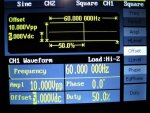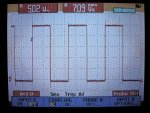180513-2356 EDT
SG-1:
For an arbitrary waveform with both AC and DC components you can not draw the general conclusion that the sum of the average DC value and the RMS value of the AC component equals the RMS value of the composite waveform.
Consider my square wave example, meaning 50% of the time one part of the square wave is more positive than the other 50%.
First, consider the + and - values to be 5 V. DC average is zero, and AC RMS is 5 V. So AC plus DC is 5 V RMS.
Second, add a +5 V bias. Now the waveform is +10 V 50% of the time and 0 for the other 50%. The average DC value is 5 V. The RMS value of the AC component is still 5 V, but the true RMS value of the composite is sq-root of ( (10^2)*0.5 ), or sq-root of 50 which equals 7.07 V. It is not 10 V.
A doorbell transformer and a battery are a good way to prove whether the AC mode includes a capacitor. Actually only the battery is needed.
Both my Fluke 27 and 87 have an input capacitor in AC mode.
In new times the ordinary electrician that does any troubleshooting probably needs a greater understanding of how their instruments, and circuit devices work.
.



